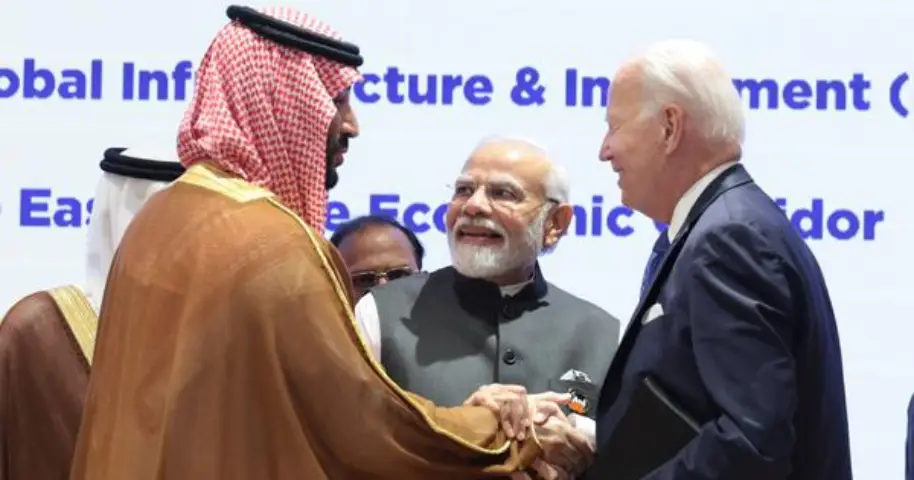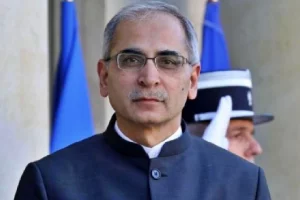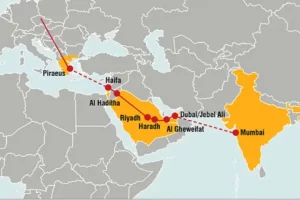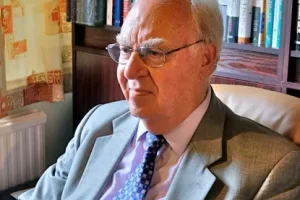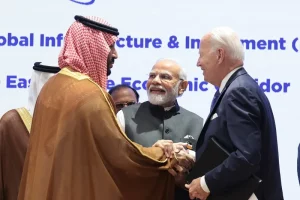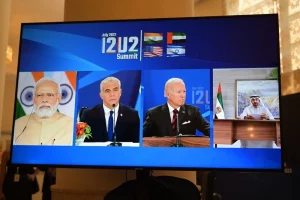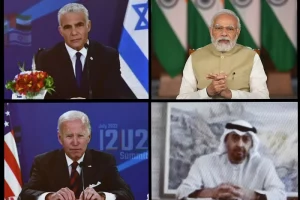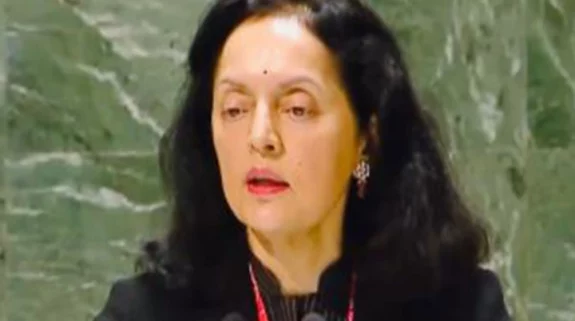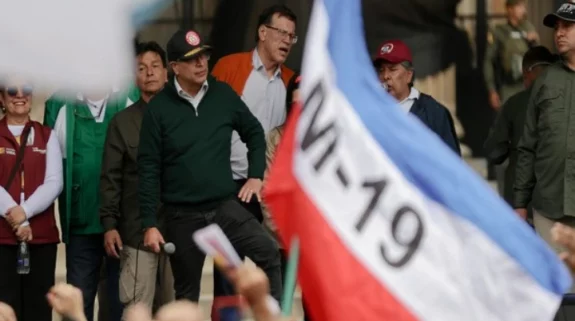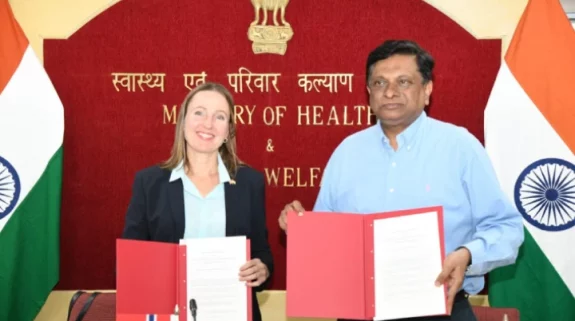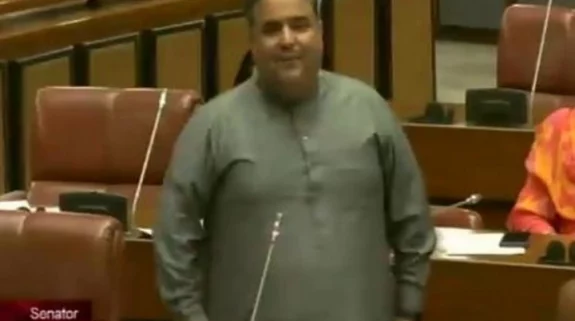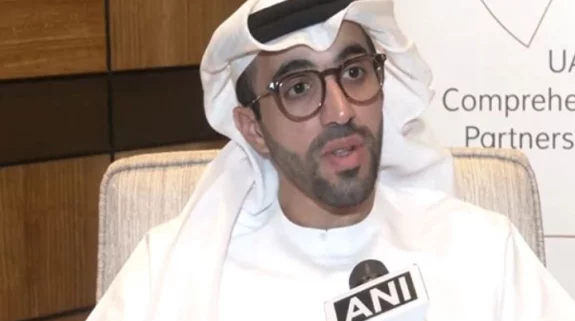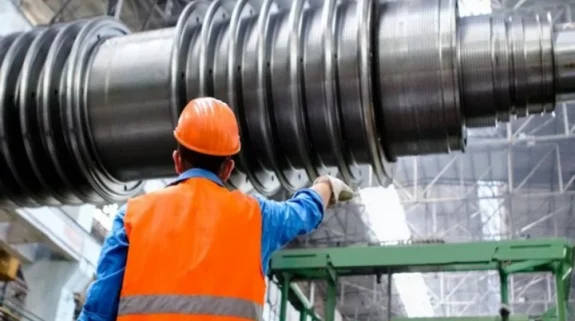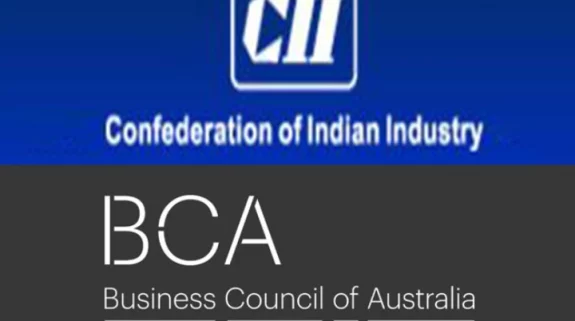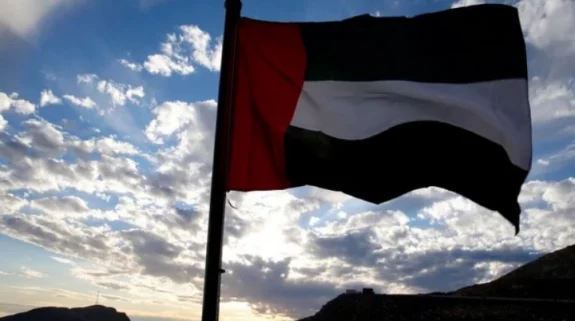The dynamics of a multi polar world changed during the G20 summit. On 9th September 2023 – on the sidelines of the G20 Summit – US President Joe Biden and Indian PM Narendra Modi co-chaired a special event on India Middle East Europe Economic Corridor (IMEC) and Partnership for Global Infrastructure and Investment (PGII). Leaders from France, Germany, Italy, Saudi Arabia, UAE, Mauritius as well as the World Bank attended the event.
The two-page MoU clearly stated that ‘it sets forth the political commitments of the participants and does not create rights or obligations under international law.’ Interestingly, the PGII, established in 2022, is a collaborative effort by G7 countries to invest in developing nations. In fact, it has been called as a ‘repackaged version’ of the Build Back Better World (B3W) initiative of Biden’s administration, which was announced in last year’s G7 meeting. But interestingly, UK , which is part of G7, was not included in the IMEC plan – speculated as one of the ramifications of Brexit. Though, UK’s PM Rishi Sunak hopes to clinch a free-trade agreement with India by Diwali 2023. At the same time, even though the US co-chaired the corridor, its name is not included, along with Israel’s.
“India-Middle East-Europe Economic corridor proposed during the Summit will become a basis of world trade for hundreds of years,” Prime Minister Narendra Modi said during his recent Maan ki Baat radio programme. He compared it with the “Silk route”, an ancient trade corridor that India had used when it was a prosperous and great trading power. By using terminology of the “Silk route” the Prime Minister was signalling that India had found an equaliser to China’s Belt and Road Initiative (BRI), which was, in its early inception, called the “New Silk route” or the One Belt One Road (OBOR).
What is the India Middle East Economic Corridor?
IMEC would comprise two corridors: the eastern corridor will connect India to the Arabian Gulf while the northern corridor will connect Arabian Gulf with Europe. Along with laying cables for digital and electrical connectivity, it also aims to create cost-effective ship-to rail transport and pipe for clean hydrogen export. In the next 60 days, the participants are set to meet to expeditiously discuss the nuts and bolts of the corridor, especially the legal, financial, technical, design and regulatory-level standards. The financial cost and the nature of investments still remain in speculation.
Unlock how the IMEC project puts India in the driver’s seat in the global geopolitical arena.https://t.co/xFSRqw74bY
— The Jaipur Dialogues (@JaipurDialogues) September 25, 2023
“Saudi Arabia’s Crown Prince Mohammed bin Salman mentioned a figure of $20 billion during the G20 announcement. It was unclear if that sum applied solely to the Saudi commitment,” said Hugh Miles, Founder at Al Shafie Miles and Arab Digest. Additionally, “it is too early to give an estimate of the cost. It will depend on several factors e.g., are the rail tracks perfectly synchronized/aligned or will they need to be changed? Similarly, what capacity electricity/data cables and hydrogen pipelines will be laid. This will depend on the potential size of the market,” said Rahul Chhabra, Former Secretary (Economic Relations), Ministry of External Affairs.
What route would IMEC follow?
A shipping route would be created from India’s Mumbai port or even the Gujarat Mundra port to UAE’s Jebel Ali Port in Dubai or Fujairah port. “I think it’s very early to decide these details of ports. Jebel Ali in Dubai, Khalifa Port in Abu Dhabi and Duqum port in Oman are connected to rail plans so they are potentially good points. I think there will be a number of technical discussions since speed and cost are the main elements,” said Mohammed Baharoon, Director General at B’huth Dubai Policy Centre.
A very well made animation of the Proposed India-Middle East-Europe Economic Corridor
This is like the Chola Empire trade in the westerly direction pic.twitter.com/SisyON0pO4— Colonel DPK PILLAY, PhD, Shaurya Chakra (@dpkpillay12) September 11, 2023
The goods would be then transported through standardised containers through rail route from Saudi Arabia to Jordan, finally ending at the port of Haifa in Israel. The plan would benefit Adani Group, which has paid $1.2 billion to gain control of the Haifa port in Israel, with a concession period till 2054. On the occasion of 30 years of diplomatic relations between India and Israel, the Israeli PM Benjamin Netanyahu had called this deal an ‘enormous milestone.’ Meanwhile, it should be noted that China’s Shanghai International Port Group, had won a 25-year tender to operate at Port of Eilat, located close to Haifa way back in 2018. This had generated harsh opprobrium from the United States, thereby coaxing Israel to look towards India, rather than chase competitive Chinese bids.
Returning to the functioning of IMEC, the Indian goods would then be transported from the Haifa port to Greece (via shipping route), finally to Italy, France eventually ending at Germany. In 2022, Saudi Arabia’s Minister of Transport Saleh bin Nasser Al-Jasser had already proposed the creation of a 5000 km railway line from the Saudi city of al-Qurayyat, located in the province of al-Jawf to the Jordanian borders.
“It should also be noted that a Hejaz railway, constructed in 1908 by the Ottoman Empire, did connect Syria to Saudi Arabia with a branch line to Haifa. In 1917, the railway was attacked by British Army officer T.E. Lawrence during the first World War,” said retired Ambassador Zikrur Rahman, Founding Director of the India Arab Cultural Centre. He added that patches of the railway track can be still seen now, and perhaps they can be repaired and remodelled for IMEC.
From 1517-1917 Turkey’s Ottoman Empire controlled what is today Lebanon, Syria, and Palestine.
This 1894 map of the Hejaz Railway shows the connection between Damascus to Haifa. There is no such country as “Israel” in the map pic.twitter.com/rOHTckMo8M— Haitham Abdelhadi (@Haitham47117914) August 3, 2023
What are the deliverables of IMEC?
“It is still unclear who is the market of IMEC, along with who is the producer and what are the deliverables along with the timeline,” speculated Johnson Odakkal, an Indian Navy veteran. As these details will evolve over time, India’s advent in the global supply chain management remains meritorious.
“It is all about supply chain management. The dollar fluctuation and oil rate per barrel would be other deciding factors. It can be speculated as a corridor to transport refined oil to Europe, especially amidst the Russia-Ukraine crisis,” said Cdr Milind Kulshreshtha (Retd.), a Strategic Analyst with expertise in C4I systems.
Currently, Indian exports to UAE, Saudi Arabia, Israel and Europe can be summed as follows. Firstly, food items, vegetables, seafood, tea, textiles (silk, cotton, wool) and chemical products to the UAE. Secondly, auto exports, sugar, iron and steel, copper, aluminium, pharmaceutical products, tea and cereals to Saudi Arabia. Thirdly, diamonds, refined petroleum, rice, broadcasting accessories, navigation equipment and precious metals to Israel. Finally, rice, jewellery, engineered goods, minerals, carpets, tea, leather hides, oil cakes, wooden furniture to Europe.
What led to the genesis of India Middle East Economic Corridor?
Called as the most consequential announcement of G20, IMEC had been created after India’s National Security Advisor Ajit Doval along with Deputy NSA Vikram Misri, for months, had intense discussions with the stakeholders prior to the G20 Summit. The genesis of it can be traced in three trajectories.
Firstly, to the I2U2 grouping of US, Israel, India and UAE in October 2021. According to the unnamed former Israeli official who spoke to Axios, it was Israel that had initially raised the idea of connecting West Asia, Europe and India through I2U2 meetings, throughout last year. Meanwhile, US President Biden also aimed to coax Saudi Arabia for cementing ties with Israel and away from China. Some analysts say that Riyadh is expected to sign a defence pact with Washington DC, get permission to install a civil nuclear programme and other incentives for detaching itself from China and Russia.
The second trajectory is on quite similar lines, but deals with American Israel Public Affairs Committee (AIPAC). “The idea of IMEC was first announced at the AIPAC meeting in Washington some months ago. Secretary of State Blinkin spoke to the pro-Israel lobby group in Washington about the Abraham Accords and about I2U2, by which he meant Israel and India and the UAE and United States. He explained how they could team up to complete the Abraham Accords and bring India into the competition with China on the side of the United States, all the while convincing the UAE and Saudi Arabia not to become too close to China,” said Joshua Landis, Sandra Mackey Chair & Director, Centre for Middle East Studies at University of Oklahoma.
Meanwhile, the third trajectory aims at PM Modi’s visit to Saudi Arabia in 2019. “The concept of the corridor was first proposed by India’s Prime Minister Narendra Modi in 2019, during his visit to Saudi Arabia. He suggested that India and Saudi Arabia could work together to create a new economic corridor that would link Asia, the West Asia, and Europe. The idea gained momentum in 2020, when India and Saudi Arabia signed a strategic partnership agreement that included cooperation on infrastructure development, energy security, and regional stability. In 2021, the United States joined the initiative as a key partner, along with the United Arab Emirates, France, Germany, Italy, and the European Union.
EAM @DrSJaishankar meets visiting Foreign Minister of Saudi Arabia Faisal bin Farhan al Saud in New Delhi
The two Ministers review implementation of Strategic Partnership Council Agreement signed between two sides during the visit of PM Narendra Modi to Saudi Arabia in Oct 2019. pic.twitter.com/ZtPFVymZHh
— All India Radio News (@airnewsalerts) September 19, 2021
The United States saw the corridor as a way to counter China’s influence and strengthen its ties with India and its allies in the Middle East. In 2022, Israel also joined the initiative as a partner, following the normalization of its relations with several Arab countries under the Abraham Accords. Israel offered its technological and security capabilities for the corridor and welcomed it as a historic opportunity to improve its relations with India, the Gulf states, and Europe,” said Dr. Ernest “Doc” Gunasekara-Rockwell, Editor-in-Chief of Journal of Indo-Pacific Affairs.
Is IMEC an alternative to China’s Belt and Road Initiative?
The Belt and Road Initiative (BRI) – also called as 21st century silk road – was first unveiled in 2013, a pertinent foreign policy maneuver by Chinese President Xi Jinping, focussing on ‘Major Country Diplomacy’ during his visit to Kazakhstan. The Communist Party of China formally adopted the Belt and Road Initiative in its party’s constitution in 2017 during its 19th National Party Congress. As of April 2023, 148 countries have signed Memorandum of Understanding (MoU) – Sub Saharan Africa (44 countries), Europe and Central Asia (35 countries), East Asia and Pacific (25 countries), Latin America and Caribbean (21 countries), West Asia and North Africa (18 countries), South East Asia (6 countries). In 2016, after Saudi Arabia, Iran and Egypt agreed to BRI, the Asian Infrastructure Investment Bank of China started operation. Along with its environmental impact, BRI has been criticized for creating a debt trap for countries like Pakistan, Sri Lanka, Cambodia and others. India has been vocally against BRI’s corridor in Gilgit-Baltistan in PoK (Pakistan Occupied Kashmir) and its real motivation behind the corridor.
Therefore, the recent unveiling of IMEC can be speculated as India’s answer to China. Yet BRI is 10 years ahead and countries like Saudi Arabia and UAE are also part of it. Meanwhile, there is no financial commitment to IMEC, as the signatories of MoU would meet in next two months to finalize the finer details.
Commemorating the 10th anniversary of Belt and Road Initiative, the Postage Stamp in Beijing along with China National Post unveiled a stamp featuring an art installation of Golden Bridge of Silk Road on 7th September. China’s President Xi Jinping will hold the 3rd Belt and Road International Cooperation Forum in October this year. While Russia’s Putin has agreed to attend it, Europe isn’t quite eager to attend. Italy has already withdrawn from BRI, which can also pave the way to future exits.
What does the United States gain from IMEC?
“A great deal of analysis points to the notion that this initiative was a way for the US to counter the Chinese belt-and-road initiative. While I think that is true, it is more pertinent to note that the US is diversifying its role in the Middle East, Indian Ocean and Mediterranean. It also wants to invest in infrastructure and not just play a role in being the main security umbrella in the region,” said Abdulaziz Alghashian, Lecturer of Politics at University of Essex, UK.
“A chief reason is to ensure the US is integrating India with nations to its west. With the most direct land routes from India to Europe having to traverse Pakistan and Afghanistan, the economic integration we’d all like to see is stymied by geography. Dedicated shipping channels could help quite a bit,” said Rick Rossow, Senior Fellow/ Wadhwani Chair in U.S. India Policy Studies at the Center for Strategic and International Studies in Washington, DC.
“Saudi Arabia and India clearly seem interested, and the US likes it because it takes attention away from China’s BRI. But I have no idea if such grand schemes are practical or can succeed. For a long time, there has been a proposal to build the Kra Canal in Southern Thailand and Malaysia, which would hurt Singapore. But despite many conversations and proposals, nothing ever came about, even though it included allied countries and what was a small project. Singapore did lobby against it, but not sure if that’s the sole reason it did not take off,” said Salil Tripathi, Senior Adviser – Global Issues, Institute for Human Rights and Business.
Criticisms and Concerns
The formation of IMEC has been a deep-rooted concern for Egypt, Turkey and other West Asian countries. Israel’s economic Globes newspaper had predicted that Egypt would lose ‘massive amounts’ of revenue generated by Suez Canal, as it is the major choke point for 10% of world trade and 7% of global oil shipment. Global shipping organization Bimco believed that IMEC could not replace the Suez Canal route but would become a niche product. Turkey’s Erdogan, quite critical of IMEC, has proposed a rival Development Road Project, which would connect the Gulf to Turkey through Iraq.
Amid established routes like the Suez Canal, Bakir perceives the #IMEC would appear to intersect and possibly undercut them, calling it “counterproductive, potentially fragmenting the regional economies rather than fostering cohesion.”https://t.co/hVL3D6z4fI
— Dr. Ali BAKIR (علي باكير) (@AliBakeer) September 22, 2023
“I am not supportive of IMEC and am sorry to see India being manipulated by US and Israeli strategists,” said Nabil Dajani, Emeritus Professor of Media Studies at Professor of Media Studies, American University of Beirut. Adding to it, “India should bet on the winning horse. The United States is perhaps on the brink of a civil war between the fanatics of Democrats and Republicans. The financial political economy of US is vulnerable, as American household debt swelled to $17.06 trillion last quarter, which could cause another financial depression like
that of 2008. Therefore, India should not jeopardise itself,” said Ahmed Moustafa, Director of Asia Center for Studies and Translation.
Conclusion: What lies ahead?
Irrespective of the pre-emptive speculations regarding IMEC, it can be assessed that it would lead to the modernising of the Indian shipping industry and better usage of Artificial Intelligence processing. Yet, India does have the challenge to ward off international water smuggling, dark ships, transit-ocean shipments, illegal, unreported and unregulated (IUU) fishing remains. Nevertheless, IMEC aims at reinventing the multipolar wheel, where geo-economics remains more crucial that geo-politics. Becoming the voice of the Global South, India has gained leverage, raising the bar for Brazil.
Also Read: Will the India-Middle East-Europe Corridor outshine or supplement New Delhi’s Eurasian outreach?






